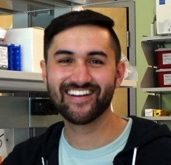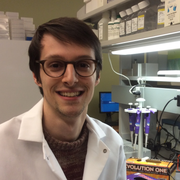Awards of $500 each were given to graduate students and postdoctoral fellows whose posters got top scores at Brain Day, based on quality of research, as well as oral and visual presentation. These posters subsequently were presented in November at the Society for Neuroscience in Washington D.C.
Top posters of postdoctoral fellows:
 Joseph-Patrick Clarke, PhD
Joseph-Patrick Clarke, PhD
Department: Neurobiology
Lab: Christopher Donnelly, PhD
Research: Inducing stress granule formation using optogenetics "The goal of this work is to generate light-induced SGs to study the role of these membraneless organelles in amytrophic lateral sclerosis (ALS) and frontotemporal dementia (FD). Our work is the first to report the formation of functional membraneless organelles using light and demonstrates spatial and temporal control in their formation in the absence of cytotoxic cell stress. Employing this method allows us to broaden our understanding of the pathobiology underlying ALS and FTD and their neuropathologies."
 Manoj Kumar, PhD
Manoj Kumar, PhD
Department: Otolaryngology
Lab: Thanos Tzounopoulos, PhD
Research: Cell-specific gain modulation by synaptically released zinc in cortical circuits of audition "We used widefield transcranial imaging of the genetically-encoded calcium indicator GCaMP6 to identify the effects of synaptic zinc on populations of specific neuronal types in the auditory cortex and two-photon imaging to interrogate the effects of zinc on individual layer 2/3 neurons. Our results highlight synaptic zinc as a novel modulator of cortical responses to sound."

Yanjun Zhao, PhD
Department:Neurobiology
Lab: Zak Wills
Research: Amyloid beta peptides block new synapse assembly by Nogo receptor mediated inhibition of T-type calcium channels "Compelling evidence links amyloid beta (Abeta) peptide accumulation in the brains of Alzheimer’s disease patients with the emergence of learning and memory deficits. We present evidence that neurons exposed to Abeta are unable to form new synapses, resulting in learning deficits in vivo."
Top posters of graduate students:

Darius Becker-Krail
Department: Psychiatry
Lab: Colleen McClung, PhD
Research: Circadian transcription factor NPAS2 and metabolic redox sensor SIRT1 interact in the mouse nucleus accumbens (NAc) to regulate cocaine reward-related behavior "Cocaine's effects on the metabolic state of the cell may feed into the circadian molecular clock and, in turn, alter reward regulation."

Sanjeev Khanna
Department: Bioengineering)
Lab: Matthew Smith, PhD
Research: Correlated variability during eye movement planning in the frontal eye fields and superior colliculus "Planning an eye movement to a visual stimulus such as looking at a traffic light at an intersection requires the coordination of multiple cells both within and between brain regions. Here we studied how groups of cells in two brain regions responsible for controlling eye movements varied their activity in relation to each other."
 Sean Piantadosi
Sean Piantadosi
Department: Psychiatry
Lab: Susanne Ahmari, MD, PhD
Research: Using in vivo microscopy to assess the role of striatal medium spiny neurons in compulsive behavior and response to pharmacological treatment "The therapeutic mechanisms of the leading drug treatment for obsessive compulsive disorder (OCD) are poorly understood. In this study, brain activity was measured in a region called the striatum in a leading genetic mouse model of OCD, using miniature microscopes that can visualize individual brain cells. This revealed that brain cells were overactive in the OCD model at baseline and that treatment with an effective OCD drug therapy normalized this activity."
"Crowd favorite" poster:
 Jacob Mann
Jacob Mann
Department: Neurobiology
Lab: Christopher Donnelly, PhD
Research: Optogenetic induction of TDP-43 proteinopathy "Aggregation of various disease-linked proteins is a common pathological process experienced in neurodegenerative diseases such as Alzheimer's disease, amyotrophic lateral sclerosis and Parkinson's disease, among others. However, experimentally controlling this process of protein aggregation has been historically problematic. Here we show a new model of protein aggregation by using light-responsive proteins isolated from plants that allows for a previously unachievable level of spatial and temporal control."
